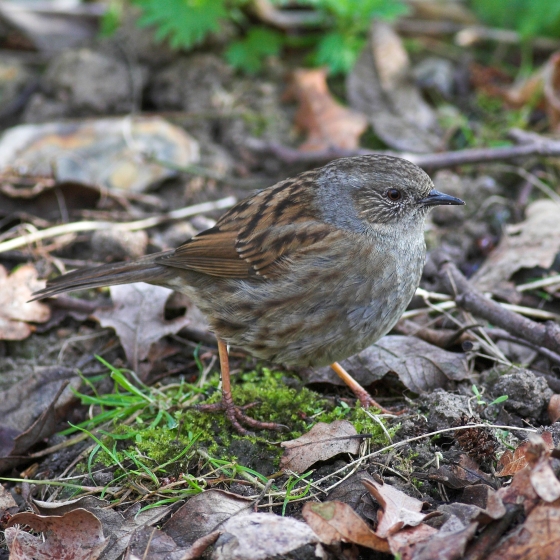Dunnock
Prunella modularis (Linnaeus, 1758)
D.
 DUNNO
DUNNO  10840
10840

Family: Passeriformes > Prunellidae

This 'little brown job' of a bird can be found throughout Britain & Ireland year round, except on the highest Scottish peaks.
UK Dunnock numbers fell sharply in the 1970s and 1980s, perhaps linked to low winter food availability. The trend has since stabilised, although recent years show evidence of another downturn. The species is on the UK Amber List.
Dunnocks are known for their interesting sex lives, with both males and females mating with more than one partner. They are quite shy and often seen on the ground, under low vegetation, giving them the colloquial name 'hedge sparrow'. In spring, males can be found on high perches singing a repetitive, squeaky song.
Exploring the trends for Dunnock
Our Trends Explorer will also give you the latest insight into how the UK's Dunnock population is changing.
trends explorerIdentification
Dunnock identification is often straightforward.
SONGS AND CALLS
Listen to example recordings of the main vocalisations of Dunnock, provided by xeno-canto contributors.
Young call
Call
Song
Develop your bird ID skills with our training courses
Our interactive online courses are a great way to develop your bird identification skills, whether you're new to the hobby or a competent birder looking to hone your abilities.
Browse training coursesStatus and Trends
Population size and trends and patterns of distribution based on BTO surveys and atlases with data collected by BTO volunteers.
CONSERVATION STATUS
This species can be found on the following statutory and conservation listings and schedules.
POPULATION CHANGE
Dunnock abundance fell substantially between the mid 1970s and mid 1980s, after a period of population stability. Some recovery has occurred throughout the UK since the late 1990s, but the species still meets amber-list criteria. The BBS map of change in relative density between 1994-96 and 2007-09 indicates that increase over that period occurred mainly in Northern Ireland and in northwestern Britain. Clutch and brood sizes, and the number of fledglings per breeding attempt all increased as the population fell and have fallen again during the recent period of partial recovery. There has been a decline across Europe since 1980 (PECBMS: PECBMS 2020a>).
| UK breeding population |
-40% decrease (1967–2022) 
|
Exploring the trends for Dunnock
Our Trends Explorer will also give you the latest insight into how the UK's Dunnock population is changing.
trends explorerDISTRIBUTION
The resident Dunnock occurs in 93% of 10-km squares both in winter and the in breeding season, being absent only from treeless stretches of the Scottish Highlands, and parts of the Outer Hebrides and Northern Isles. Densities in both seasons are highest in south and east Ireland and throughout much of lowland England.
Occupied 10-km squares in UK
| No. occupied in breeding season | 2792 |
| % occupied in breeding season | 92 |
| No. occupied in winter | 2809 |
| % occupied in winter | 93 |
European Distribution Map
European Breeding Bird Atlas 2
Breeding Season Habitats
| Most frequent in |
Villages 
|
| Also common in | Scrub, Arable Farmland, Pasture Farmland, Towns |
Relative frequency by habitat
Relative occurrence in different habitat types during the breeding season.

DISTRIBUTION CHANGE
Dunnock distribution has changed little since the 1970s; some apparent gains in the uplands of northwest Scotland, on Orkney and the Outer Hebrides may reflect improved coverage. However, relative abundance has increased in many parts of Britain & Ireland since the early 1990s.
Change in occupied 10-km squares in the UK
| % change in range in breeding season (1968–72 to 2008–11) | +0.7% |
| % change in range in winter (1981–84 to 2007–11) | +6.9% |
SEASONALITY
Dunnock is recorded throughout the year though can be more skulking after breeding in late summer and early autumn.

Movement
Information about movement and migration based on online bird portals (e.g. BirdTrack), Ringing schemes and tracking studies.
RINGING RECOVERIES
View a summary of recoveries in the Online Ringing Report.
Foreign locations of birds ringed or recovered in Britain & Ireland

Biology
Lifecycle and body size information about Dunnock, including statistics on nesting, eggs and lifespan based on BTO ringing and nest recording data.
PRODUCTIVITY & NESTING
Exploring the trends for Dunnock
Our Trends Explorer will also give you the latest insight into how the UK's Dunnock population is changing.
trends explorerSURVIVAL & LONGEVITY
View number ringed each year in the Online Ringing Report
Maximum Age from Ringing 
|
10 years 7 months 23 days (set in 2012) 
|
Typical Lifespan 
|
2 years with breeding typically at 1 year |
Adult Survival 
|
0.473±0.012  
|
Juvenile Survival 
|
0.347 (in first year) 
|
Exploring the trends for Dunnock
Our Trends Explorer will also give you the latest insight into how the UK's Dunnock population is changing.
trends explorerBIOMETRICS
Wing Length 
|
Adults | 69.9±2.1 | Range 67–73mm, N=24215 |
| Juveniles | 69.4±2 | Range 66-72mm, N=23776 | |
| Males | 70.7±1.9 | Range 68–74mm, N=6571 | |
| Females | 68.8±1.9 | Range 66–72mm, N=3114 |
Body Weight 
|
Adults | 21.2±3.1 | Range 18.6–24.0g, N=19587 |
| Juveniles | 20.5±2.1 | Range 18.1–23.2g, N=19030 | |
| Males | 20.9±3.2 | Range 18.7–23.1g, N=5345 | |
| Females | 20.9±2 | Range 18.1–24.5g, N=2513 |
Feather measurements and photos on featherbase 
CODES & CLASSIFICATION
Ring size 
|
B |
Field Codes 
|
2-letter: D. | 5-letter code: DUNNO | Euring: 10840 |
For information in another language (where available) click on a linked name
Research
Interpretation and scientific publications about Dunnock from BTO scientists.
CAUSES AND SOLUTIONS
Causes of change
The decline of the species between the mid 1970s and mid 1980s is likely to be due to several factors, but strong experimental evidence in farmland areas suggests that this may be linked to reduced winter food availability. This reflects similar results found for other species that suffer a 'hungry gap' in February and March.
Further information on causes of change
The cause of the decline between the mid 1970s and mid 1980s is unknown, but a recently constructed integrated population model suggests that variation in adult survival plays a key role in determining annual population change (Robinson et al. 2014). It is possible that decline was limited to the farmland and woodland habitats that were covered by CBC, prior to the inception of BBS in 1994.
Feeding experiments have revealed that the use Dunnocks make of farmland feeding stations peaks after mid February, as natural food becomes depleted, suggesting that food availability on farmland is a limiting factor in the population (Siriwardena et al. 2007, 2008). This reflects similar results found for other farmland birds that experience a 'hungry gap' in February and March (Siriwardena et al. 2008). Evidence from the study also suggested that breeding abundance was stable where the use of provided food was high, although this may be a density-dependent result as high use occurred at high abundance (Siriwardena et al. 2007).
The CBC trend in woodland plots suggested that the species had declined by 58% between 1966 and 2000 (Fuller et al. 2005). The most likely cause for this decline is loss of understorey due to canopy closure, in the absence of forest management and especially to increasing browsing pressure from deer (Gill & Fuller 2007). In Bradfield Woods, Suffolk, Dunnocks responded negatively to browsing pressure (Holt et al. 2011). Shrub density has been identified as the most important predictor of Dunnock abundance at this site (Fuller & Henderson 1992).
Information about conservation actions
The most likely driver of the decline of this species on farmland during the late 1970s and 1980s was agricultural intensification and reduced winter food availability. The Dunnock is affected by the 'hunger gap' in late winter (Siriwardena et al. 2008; see Causes of Change section, above) and therefore ensuring food is available after mid-February is likely to be particularly important. Conservation actions and agri-environment options which could help achieve this include supplementary feeding (Siriwardena et al. 2007) and other actions which increase winter food supply such as the planting of wild bird seed cover, the retention of stubble fields, and the use of buffer strips, conservation headlands, set-aside and similar habitats to increase the availability of natural seed resources.
The species is also declining in woodland, where the main cause is likely to be the closure of the canopy and increased levels of deer browsing leading to loss of shrubs in the understorey. Therefore, active woodland management to create a more open canopy and to control deer numbers may create better habitat conditions for Dunnocks.
Links to more studies from ConservationEvidence.com
- The effect of the spatial distribution of winter seed food resources on their use by farmland birds
- The effects of grassland management using fire on habitat occupancy and conservation of birds at a mosaic landscape
- Could game management have a role in the conservation of farmland passerines? A case study from a Leicestershire farm
Would you like to search for another species?












Share this page